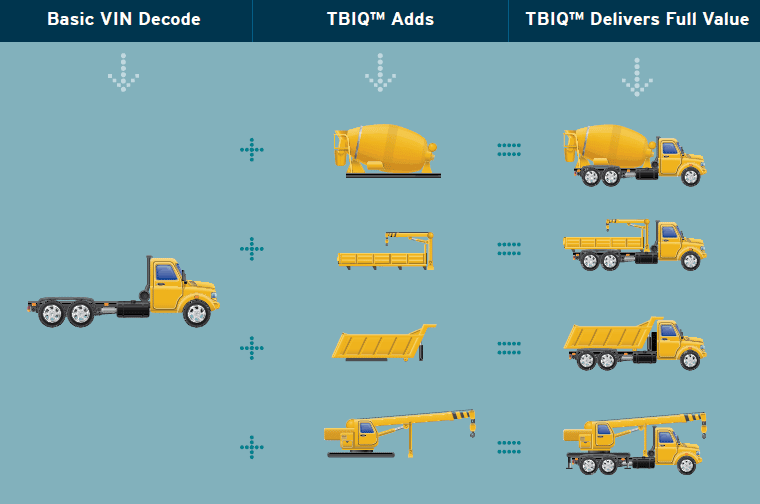Predicting Upfit and Why It Matters
When Price Digests conducts reviews of insurance carrier books, there is often one metric that surprises the carrier most: just how many incomplete commercial trucks they are insuring. In some cases, it has been over 65% of the trucks insured by the insurance carrier. Often, this designation—and the implications it has—are not fully understood by insurance carriers. Even if the risks and opportunities for premium leakage are understood, carriers are often left wondering what they can do about it. After all, speed to quote and ease-of-use for agents are highly important factors and often these outweigh any additional analysis it could take to discover a truck’s completed body and thus true original cost new (OCN).
To demystify the topic, we’ve put together a primer on what an incomplete truck is, how to tell if a vehicle is classified as incomplete, and what implications this status has on values. We will also share how Price Digests is helping insurance carriers act on this information without introducing delays in the quoting process or overwhelming agents with too much data.
What is an incomplete truck?
An incomplete truck is just a cab and chassis, stripped chassis, or cutaway van without a body or equipment attached. Incomplete vehicles require customization before they can begin their useful life. This customization is specific to the unique needs of the business and reflect the specialized applications of the truck, such as within the construction, food transportation, utility, or medical transport industries.
The process of attaching a useful body is called “upfitting” and it is not until a vehicle has been upfitted that it is considered a completed truck. Legally, per the National Highway Traffic Safety Administration (NHTSA), the upfitter is considered the final-stage manufacturer and has responsibilities as such, including certifying emissions requirements.¹
Why are trucks produced incomplete?
Vocational trucks can be as varied and custom as the industries in which they operate. The same incomplete vehicle could be upfitted with a wide variety of bodies, including a concrete mixer, crane, or dump body, just to name a few. Because the final configurations can vary so much and be so specific to the industry in which it will be used, original equipment manufacturers (OEMs) often find it more efficient to produce just the cab and chassis and allow for final customization elsewhere. Upfitters can then specialize in certain bodies and serve their industry’s niche needs.

Can a VIN tell you if a truck is complete or incomplete?
When a manufacturer assigns a VIN to a commercial truck, the VIN contains many critical details about that truck, including its manufacturer, model, year, trim, major components, and weight. Additionally, the VIN reveals if the vehicle was “complete” or “incomplete” when it left the factory. Importantly, for incomplete vehicles the VIN does not specify the final, upfitted configuration of the truck. This is because VINs are assigned before the upfitting process takes place and the final form is unknown to the OEM.
How does upfit impact a truck’s value?
The OCN for a completed truck can be, and often is, dramatically higher than the incomplete version of that vehicle. It is not uncommon to see OCN more than doubling between the incomplete and complete status. This is because the truck body itself is often worth more than simply the cab and chassis it is being affixed to.
Below are some real-world examples of OCN for incomplete trucks, their upfitted truck body, and their completed configuration. With the first example of the Dodge 5500, its incomplete status has an OCN of $38,025. This vehicle can be completed with an articulated tree lift with a value of $71,485. Adding this particular body increases the total OCN dramatically—nearly three times what the incomplete truck was worth.
| OCN | Truck Body | Total OCN | Lift | |
|---|---|---|---|---|
| Dodge 5500 | $38,025 | Art. Tree Lift $71,485 Wrecker Flatbed $32,167 |
$109,510 $70,192 |
288% 185% |
| GMC Chevy 3500 | $41,140 | Art. Tree Lift $70,280 Wrecker Flatbed $30,962 |
$111,420 $72,102 |
271% 175% |
| Kenworth T300 | $73,750 | Fiberglass 150″ $31,339 Fiberglass 107″ $24,296 |
$105,089 $98,046 |
142% 133% |
How can I discover a truck’s completed configuration?
To be absolutely sure of a truck’s final upfit, you would need to see and inspect the vehicle. Next to personally identifying the final buildout, the owner could also inform you of the truck’s completed configuration, but the accuracy there would of course be subject to the owner’s own knowledge.
While it is true that the types of bodies that can go on a given incomplete vehicle are quite varied, there can be some clues to help you narrow it down. For example, if the vehicle is in a fleet owned by a utility company, it may be unlikely that the final buildout would be for a concrete mixer.
However, even though you could investigate the vehicle yourself, you could interview the owner in detail, and you could even go through the steps to deduce a reasonable final upfit, these are obviously time-consuming and tedious tasks that can be prone to error. With speed to quote and ease of use being an imperative for insurers, these are not feasible solutions.
To better help our clients through this process, Price Digests has developed Truck Body IQ™. Based on our decades of experience with commercial truck and specialty truck bodies data, this new solution leverages intelligence algorithms to predict the most likely upfitted truck bodies. This allows us to provide a much more realistic range of upfitted body values, helping our customers reduce their risk from inaccurate OCNs. Because Truck Body IQ™ works in conjunction with Price Digests’ API, getting this more accurate and detailed information does not slow down the speed to quote and can be fully integrated into existing policy admin systems.
To discuss how adding advanced intelligence and automation, like Truck Body IQ™ from Price Digests, can help reduce exposure within your current book of commercial lines business, mitigate costly premium leakage, or learn more about Price Digests’ comprehensive commercial vehicle data solutions, contact us. We will demonstrate how our solutions improve process efficiency and support premium lift for your company, and we can provide a complimentary analysis of your existing book of commercial auto business.
PriceDigests.com/TBIQ | 866-934-2684 | [email protected]
Articles referenced:
[1] Commercial Vehicle Certification Series — Part One. Retrieved October 15, 2021.




